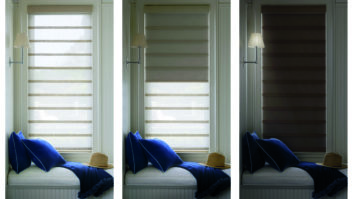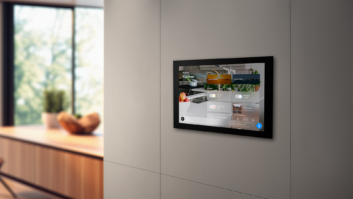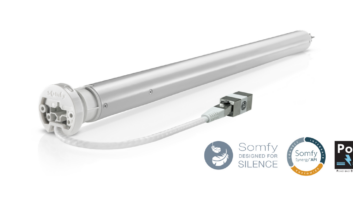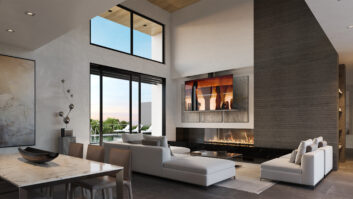For average folks, just the thought of a “whole-house integration” might seem daunting. They might not know where to begin. But for a custom A/V installer, providing a total solution for an integrated home isn’t just part of the business, it is the business, as they install audio, video, lighting and automation systems.
Now, there’s a new aspect of home control that is quickly becoming an essential add-on to any modern systems installation–motorized window shade control. Previously in the dark, shade control is now in the spotlight, and grabbing the attention of curious homeowners. In each residence-new or old–are windows. Naturally, on the windows are shades or drapes of some sort. About 15 years ago manufacturers and installers began to seriously address this feature of home automation, an option that was met with general trepidation by clients. But as the industry expanded and success stories leaked out, business opportunities for shade control have significantly grown. Some firms are now reporting that up to 50 percent of their jobs include window shade control systems, and more custom contractors have begun promoting their capabilities as shade control installers. In the short term, a shade control product is a maintained profit margin item, which is advantageous for the custom installer. And the long term nature of this success will only become more important for the industry in coming years.
Chris Kangis, owner and systems designer of Electronic Interiors Inc., asks, “If the client wants complete home automation, who is going to do it…various people for various jobs? And if they want shade motorization, who will motorize it? Will it be window treatment/interior designers?” Kangis decided years ago–and he hopes other installers concur–that there should be only one central integrator for custom installation project.
Kangis joined the industry in 1984 and has been specializing in A/V installation since 1991. For the past seven years he has been offering shade control, in addition to traditional A/V systems, to his clients. Kangis decided to get involved with window shade control not because he wanted to do more jobs, but because he wanted to do less jobs with more systems in them. “The philosophy of home automation is primarily to do things for the homeowner that he/she cannot or should not do for themselves. Likewise, with window treatments, 26 cellular shades should be automated and equipped with presets.”
Kangis also suggests that installers should work with a local shade vendor if they don’t want to do the installation themselves. “Shade install is one more thing you can offer to provide a total solution, even if you don’t deal with it directly,” he said.
“People absolutely love it,” said Doug Buday, owner of the Michigan-based installation firm Buday’s Sound Advise, who has been installing shade controls for the past eight years. “We work on many homes here in Northern Michigan that overlook the Great Lakes, and these homes have many large windows. Homeowners love that you can get all the various controls down to a single gang, and that with the touch of one button they have complete control of their lighting and their shades.”
Buday has been in the custom installation business for 25 years, with the past 15 years specialized in custom A/V systems. “People are starting to show more interest in this aspect of a job, and awareness of motorized lines is really starting to grow,” Buday said. “If you are installing lighting controls and you are automating that feature of a residence, integrating shades is the next logical step. “Right now 50 percent of our jobs include motorized shade control.” Companies like BTX, Techniku and Lutron/Vimco are currently manufacturing motorized window shade controls. The Lutron Sivoia is a popular new motorized shading item, according to various installers, because it is extremely quiet, low-profile, and offers accurate presetting options for homeowners.
Inside almost every standard motorized shade control is a Somfy Systems motor. Somfy Systems, a France-based manufacturer with an office in Canterbury, New Jersey, specializes in motors for window shade treatments and filmscreens. Christopher Kahler, market development manager for Somfy, is responsible for integrating Somfy motors and controls with home automation companies around the world. He works with builders, designers, integrators and window treatment manufacturers to promote the Somfy name.
“Somfy motors and controls make moving your awnings, rolling shutters, window treatments and other roll-up applications convenient and virtually effortless. Our quality products have been installed all over the world for almost three decades within residential, commercial and industrial building structures,” Kahler said. For the integration market, Somfy offers the IGC/3N1, an individual group control and or individual control of each motor. IGCs can be daisy changed to several IGC/3N1 controllers but not exceed the amp load of the circuit.
Somfy’s GSC-Group control station can operate up three motors as a group, and can be daisy changed to several GCS controllers but, also, not exceed the amp load of the circuit. The RS-232 allows for communication to automation systems via protocol. At the CEDIA EXPO, last month in Indianapolis, Indiana, Somfy had various exhibits for both window treatment motors and controls, which are both selling in tandem.
The Indiana-based Draper Inc. recently launched a new line of recessed window shades that emphasize the convenience of window shade controls in home theaters. Draper’s Access, Ultimate Access and Access Dual Roller FlexShades are among the new offerings. The Access FlexShade features an extruded aluminum headbox which installs above the ceiling during the “dirty” phase of construction. A flange along the bottom front of the case can support acoustical ceiling tile or trim the opening. The bottom panel is easily removable without tools, and forms a slot for passage of the fabric. The motorized shade installs in seconds with preset latching roller brackets.
The Ultimate Access FlexShade also offers what the company has deemed the “headbox now, shade later” advantage, along with the ceiling tile flange for recessed installation, according to Bob Hadsell, Draper’s home theater manager. With this particular shade design–a single motorized shade in an extruded aluminum headbox and ceiling closure that opens into the case–the shade is completely hidden from view when closed. For the multi-purpose room, Draper offers the Access Dual Roller FlexShade System for glare control and room darkening. Two shades are vertically stacked in a single recessed headbox, allowing a glare control fabric-mesh or translucent-and a room darkening shade. The Access Dual Roller FlexShade headbox is white at the ceiling line. The Access Dual Roller also offers the option of combining a room-darkening LightBloc shade with a front projection screen, for those rooms where the best place for the projection screen is in front of a window.
Integrating window shade controls to home theaters has, for years, been understood to be natural aspect of home theater convenience. Now, custom installers are promoting other benefits of automated window shades.
According to Kent Van Hoesen, president and owner of Radius Systems Integration, of Lawrence, Kansas, lighting control gives better use of the dollar, and better investment, than anything else done with home automation. “You might use a CD player three hours a day. But lights and shades are used all day long, or 8-10 hours a day, with 100-200 light switches in one home.”
Van Hoesen also contends that the “wow” factor is important in his shade installations. “Window shades are the nicest add-ons to automation system because no other aspects of control is really visible. But with shade control, homeowners are constantly reminded about how easy the process of shade control has become for them.” Another key selling point of shade controls is the ability to manage the potential damage to homes and furnishings. A beautiful home can’t risk what solar impact may do to fabrics on couches and rugs, so solar blocking shades become increasingly important. Also germane are shades that will automatically come down during the hours of afternoon glare. And residences with southern exposure, who experience longer “summer seasons” will save money because the central air conditioning system won’t have to work as hard. For the plethora of advantages shade control offers, there are also challenges. According to Lutron Electronics sales engineer Benjamin Grass, shade controls are a tough technology to master. “Not many A/V contractors will take new products and test them in their client’s homes,” he said. “But the products need to be tinkered with and integrated to prior to installation.”
Van Hoesen agrees. “The technical side of window shades is simple. But the coordination is tricky,” Van Hoesen said. “With some shade projects there are no mathematical figures; they are completely in the physical world. So I spend hours planning it, as it is very expensive to make corrections or modifications once they are up. You have to work closely with the builder and interior decorators, too.” Collaborating with interior decorators is yet another challenge, according to Van Hoesen, because to them, home automation is like a new language, with new specs. “Working with interior designers was a true learning curve for me,” he said. “It is hard for them to understand and to learn about what I’m doing. Automation is in a completely different world.”
In one of his more unique projects, Van Hoesen recently covered a 45-foot undulating wall by hanging motorized vertical blinds on a curved track. He used curved track from AM Source, a Chicago-based manufacturer.
“The trick to hanging treatments on a curved track is attention to detail, matching the right curve and making a perfect fit,” he explained.
Currently, Kangis and his design team are working on a job in Martha’s Vineyard with 10 full-size window doors. This project was different for Kangis because the homeowners, before even hearing about shade control, had already researched products and decided on the one they wanted. Needless to say, Kangis was pleased. “This feature is really taking hold of this industry professionals and consumers,” he concluded. “Soon shade control will be an integral spec for every job, just like home theater has become an understood element of a custom installation.”
–Margot Douaihy is managing editor of Residential Systems.







